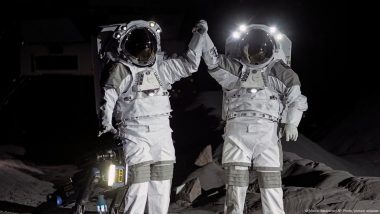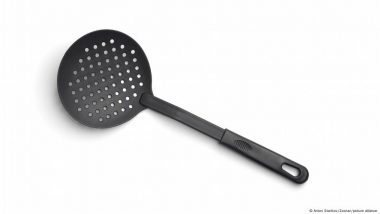Getting to the moon takes a lot of small steps, like Europe's new LUNA training facility. But it's not there yet. Next step: a moon gravity simulator.If you were to recreate the moon on Earth, you would need three essential ingredients:
a sandy material with a chemical composition like regolith (lunar soil)Also Read | Solar Eclipse 2024 Facts: From Types of Eclipses to Cultural Myths, Ahead of 'Ring of Fire' Celestial Event, Know 5 Interesting Things About Surya Grahan.
special lighting to mimic the angle of the sun
a moon gravity simulator (the moon's gravity is one-sixth of the Earth's gravity)
And a huge container to house it all, like a massive metal hangar.
When the German Space Agency (DLR) and European Space Agency (ESA) unveiled their version of the moon — the LUNA Analog Facility — in late September 2024, they got two-thirds of the way to representing the moon's strange landscape. One crucial element was missing.
Pitch darkness was broken by a spotlight trained on two fully-suited astronauts — Germany's Matthias Maurer and France's Thomas Pesquet.
Maurer and Pesquet marched across the hangar, with its 700 square meters (7,500 square foot) of artificial regolith, made from the volcanic soils of Italy's Mount Etna, Germany's Eifel region and rocks from Norway.
Equipped with long-handled scoops, a sample trolley and robotic dog, the pair pretended to explore the fake lunar surface in front of about 100 dignitaries.
As they walked, the light shone from a precise angle to simulate how the sun will obstruct an astronaut's vision when humans return to the moon, possibly this decade.
But they walked — they didn't bounce as in footage from the 1969 Apollo 11 mission — because LUNA has no lunar gravity.
Gravity simulator: Missing piece of the LUNA puzzle
Against a cinematic soundtrack, Maurer and Pesquet demonstrated how they would collect samples and explore a crater on the real moon. It was a spectacle for the politicians and agency officials, who fist-bumped the astronauts for the TV cameras and their crews.
But it felt so earthly without a moon-like gravity. It's a problem the engineers have yet to solve.
In the past, astronauts have used parabolic flights and swimming pools to simulate and experience the effects of zero or microgravity.
Parabolic flights use refitted jet aircraft to recreate the loss of gravity by ascending to and descending from high altitudes at 45 degree angles.
Astronaut training swimming pools are also specially equipped, and the astronauts perform mock exercises in spacesuits.
But neither of these options would work in the LUNA Analog Facility because it's on dry land.
Instead, engineers hope to develop a "gravity offload system," said Andrea Emanuele Maria Casini, an aerospace engineer, who manages the LUNA project.
"You have to imagine it like hanging the astronauts as puppets," Casini said.
Cables will be attached to the exterior of the astronauts' spacesuits, likely pulling back on them as they walk and suspending them as they jump.
The project is still in the prototyping phase. And until its arrival, Casini agreed: LUNA is a very expensive sandpit. But eventually they will want to test new technologies and train astronauts in a closed environment.
"The magic happens inside," said Casini. "The terrain will help the next generation of astronauts go back to the moon."
And there is room for expansion. There are two additional modules next to the LUNA Analog Facility — a habitat simulator and a repurposed greenhouse from an experiment called EDEN ISS, which simulated food cultivation in cold space environments.
Adjacent to the main hall, there's a vacant lot, which may be used for a future "LUNA 2" or Mars training environment.
The moon brought down to Earth
The LUNA Analog Facility has been in development for 12 years. Maurer, who has spent 177 days in space, has driven idea from day one. He told DW the facility captured the realities of the moon, even without the gravity offload system.
"When I step down into the crater [in the facility] and have the sunlight fully in my face, I'm blinded," said Maurer. And because he's in a crater, everything in front of him is cast in darkness by the shadow of the crater ridge.
It's a stress test for astronauts, exposing them to the difficult and sometimes contrasting conditions they will encounter on the moon.
Another factor is the moon's regolith. "It's a major technical obstacle," said Maurer. "It destroys all electrical equipment, it gets into moving parts and blocks them, and it gets into the space suit. We can test [all that] here."
Links around the globe
LUNA can hook into mission control centers across the planet: From DLR in Cologne and the German Space Operations Center (GSOC) in Munich to NASA in Houston, US, and the International Space Station.
That means simulations could be run remotely: NASA astronauts could be guided through a mission simulation in Germany by their teams in the US.
When fully functional, the LUNA Analog Facility will stand as a totem of Europe's commitment to space, said ESA's special advisor for political affairs, Kai-Uwe Schrogl.
"[LUNA] provides credibility," Schrogl said. "You can talk a lot about going to the moon and beyond, but if you only have a few rockets or a lander on the drawing board, then you are not really credible. You need such a facility to show that you are serious."
Aside from aiding NASA's Artemis program, Europe has its own ambition of getting to the moon by the 2030s. The LUNA Analog Facility is one of many small steps to achieve that goal.
Edited by: Zulfikar Abbany
(The above story first appeared on LatestLY on Oct 01, 2024 07:20 PM IST. For more news and updates on politics, world, sports, entertainment and lifestyle, log on to our website latestly.com).













 Quickly
Quickly




















